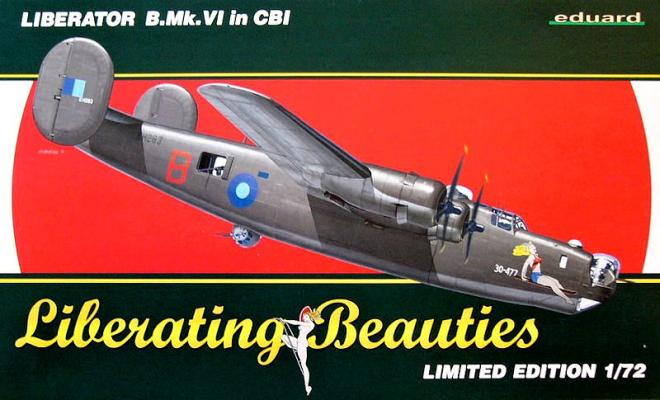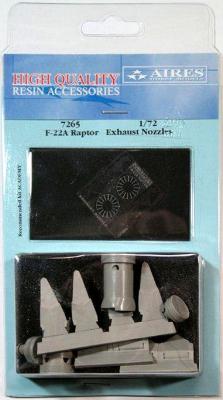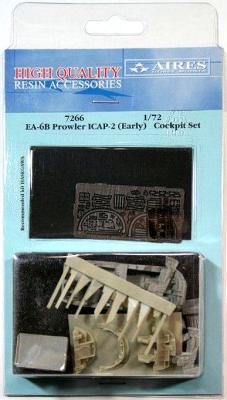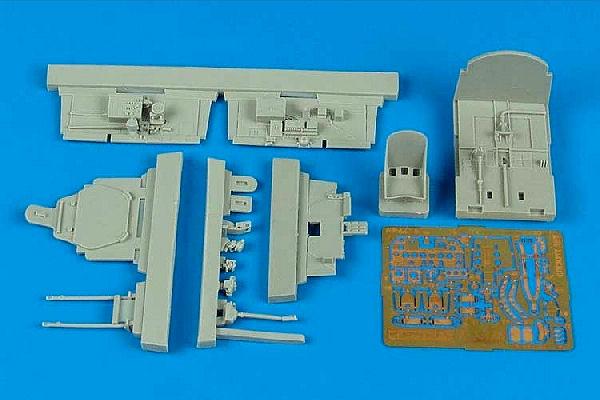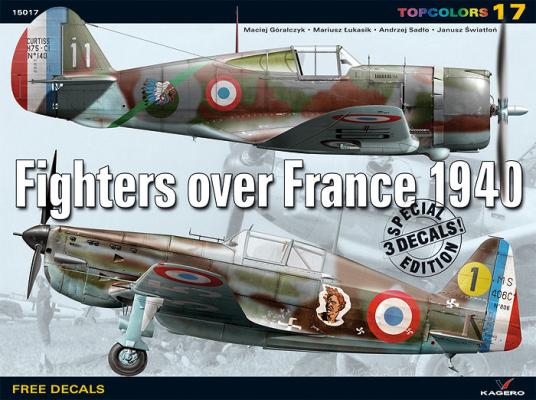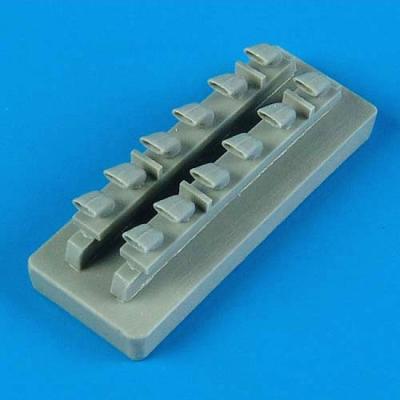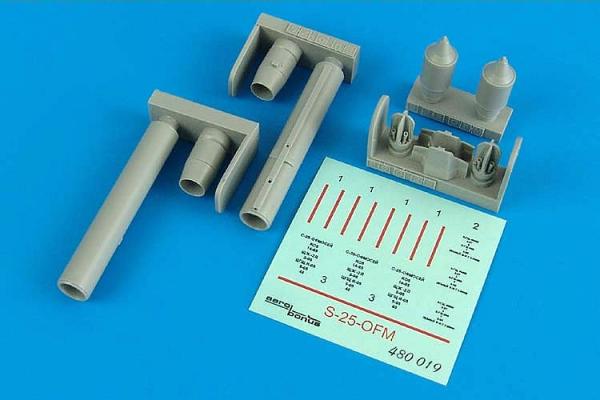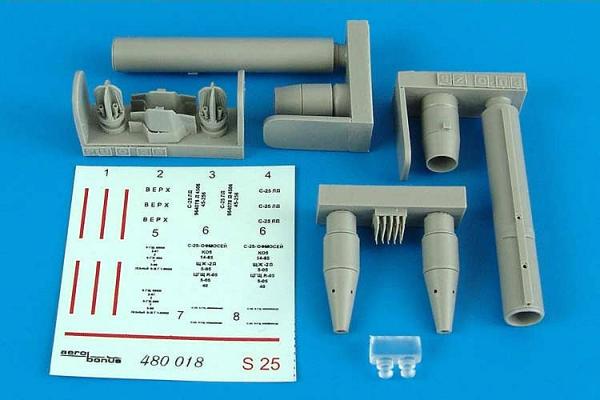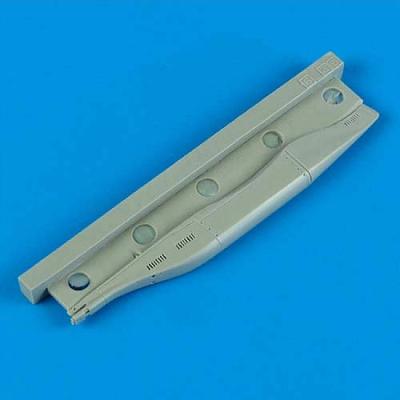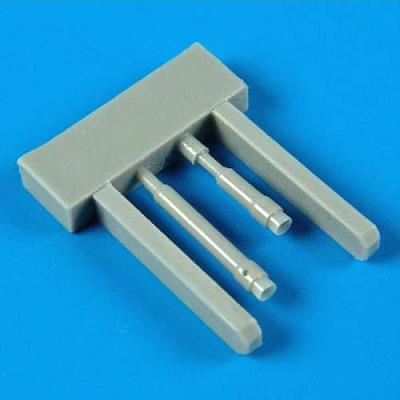Although the B-24 Liberator shared the honors with the B-17 Flying Fortress of being the principal American heavy bomber of World War II, it was a much later design. It incorporated several unusual design features, including the Davis patent wing of very thin section and high aspect ratio, and bomb bay doors which rolled up like the top of a roll-top desk. This feature was created to make it more difficult for enemy fighters to know when the bomber was on its final bomb run. The doors moved up the side of the fuselage instead of hinging down as in the B-17. The B-24 had a range of 3,000 miles, together with a speed of more than 300 m.p.h. and a ceiling of 35,000 ft. The B-24Hs in RAF service were fitted with Boulton Paul tail turrets, but retained the rest of their standard armament.
Aires specializes in creating replacement parts for kit items that are either lacking in detail or have detail that isn’t quite sharp enough. This set provides replacement parts for the exhaust nozzles for the Academy kit of the F-22 Raptor.
The set is cast in medium grey resin, with no pinholes or miscast parts, along with a nice photoetch sheet for fine parts. The set includes the aft end of the turbine compressors and the afterburner section. The flame holders from the PE sheet are attached to the end of the compressor section, then the afterburner tube is added. The four long triangular pieces are the side pieces of the vectoring nozzles, and the smaller, wider, triangles are the vectoring parts of the nozzles. Each of them receives one of the four “batwing”-shaped pieces of PE, adding to the detail.
Aires has presented us with another beauty here. I’ve wanted to build an EA-6B for quite some time (I have a bit of a background in electronic countermeasures). The only kit in my chosen scale of 1/72 is the Hasegawa kit. This kit is typical Hasegawa of its era, with finely engraved panel lines, minimal necessary external accessories for the version being done, and not much in the cockpit area. This set takes care of the last part completely.
As usual, the set is flawlessly cast in a medium grey resin, with incredible detail just begging to be painted and highlighted. Also included is a photoetch sheet with instrument panels, seatbelts, and other cockpit accoutrements, and a clear acetate sheet with the backing for the instrument panels.
Made specifically for the Tamiya 1/48 scale P-47 Bubbletop, this comprehensive aftermarket set comes in Aires’ usual blister package. Separately ensconced in a secondary bubble are photo etch and film parts, along with the usual blue instructions.
In fact, the instructions alone come in for any criticism that may be reasonably leveled at this set. They are composed entirely of minimalist exploded drawings spread over two sides of a single folded sheet of paper, with only number callouts and small notations in both English and Czech. There is no history or background text, and the modeler is left to his own devices concerning colors and, in many cases, actual part placement. However, none of this is really a detriment, and any halfway competent modeler with a reference book or two in his library will overcome nicely.
This is essentially a book of lovely color aircraft profiles! There are 16 aircraft covered by this book: three D. 520s, two Hawk 75s, 4 MS 406s, one Bf-110C, and six Bf-109Es that were engaged in the Battle of France in 1940. The profiles are beautifully drawn and each is accompanied by a short caption in both English and Polish detailing a short history of the pilot and aircraft depicted.
Accompanying the book are decal sheets in 1/32, 1/48 and 1/72 for all of the aircraft illustrated within. The profiles serve as the placement guide for the decals. The decals themselves are absolutely gorgeous! They are well printed, in register, with vibrant colors. The sheet illustrated with this review is the 1/32 sheet, but all markings are on the sheet for each scale. The decals are printed by Cartograf, so you know they are good. I will need to dig the old Medallion 1/48 resin Hawk 75 out of the stash and buy an AZ MS 406 to put these to good use.
The HobbyBoss kit of the Ta-152C-0 is the first all-injected version of this prototype aircraft. If you are like me, you can never consistently open the ends of the exhaust stubs to make them look realistic. I’m thankful for Quickboost, as they have some of the best examples that are easy replacements for the kit items and have the look I’m after.
This set contains two exhaust stubs molded in light grey, blemish-free resin. Removal from the pour blocks is simple enough. Just add paint and add to the kit. Really simple and effective.
Highly recommended.
Thanks to Quickboost and IPMS/USA for the review sample.
AeroBonus is a specialized company from Aires that concentrates on Soviet wing stores. The latest release is a couple of air to ground rockets. Molded on four pour blocks with some exquisite detail, these unique looking rockets are quite impressive. There are two mold blocks with the rocket bodies. The other two are warheads on one and tail units on the other block. I really liked the rocket flutes on the tail which are petite and perfectly cast. Quickboost uses light grey resin that has no imperfections. Removal is easy and assembly will represent no problems, even to beginning resin users.
Soviet underwing armament is quite unique looking when compared to the US equivalents. These rockets are no exception. Perfectly cast on four light grey resin blocks, with a block of clear resin “nose cones” and decal markings, these are some really nice additions to your Soviet aircraft.
The resin is flawless. Two of the pour blocks are the rocket launcher bodies. The other one is the rocket motors with some exquisite detail, especially the rocket flutes. The final grey piece of resin is the unique shaped-charge warhead and control fins. The fins will require care to prevent them from flying off, as they are very petite but realistically thin. The clear pour block has the rocket tip for these particular rockets.
The Academy Mig-21 kit is a nice kit. However, the parts breakdown of certain pieces is a pain. This is apparent especially on the kit gun pods. The kit part has a seam right down the middle which will be difficult to fill. The kit pod also has minimal detail and some shape issues. The Quickboost resin cannon pod has exquisite detail. The vents and fasteners are perfectly represented, but the best feature is the drilled-out gun barrels. I’m sure I could not drill them as well as Quickboost because these things are so small that I’m sure I would have just made a mess of it.
The single piece is molded perfectly in light grey resin. Removal is quite easy and adding it to the belly is easy enough as long as you don’t cut off the mounting stubs. The Quickboost pod has a more accurate shape, especially around the front portion.
Highly recommended.
Thanks to Quickboost and IPMS/USA for the review sample.
Hobby Boss seems to be producing almost every version of the Me-262. The upgunned U-5 version is a nice looking kit. However, cleaning up the gun barrels is a pain. Also pains to maintain are the roundness and drilling out the center hole. Quickboost addresses both of these issues.
This is a small set, cast perfectly in a light grey-green resin which contains the two cannons that are direct replacements for the kit parts. They are perfectly round and have the barrel thinned out. It is simple and easy.
Highly recommended.
Thanks to Quickboost and IPMS/USA for the review sample.

